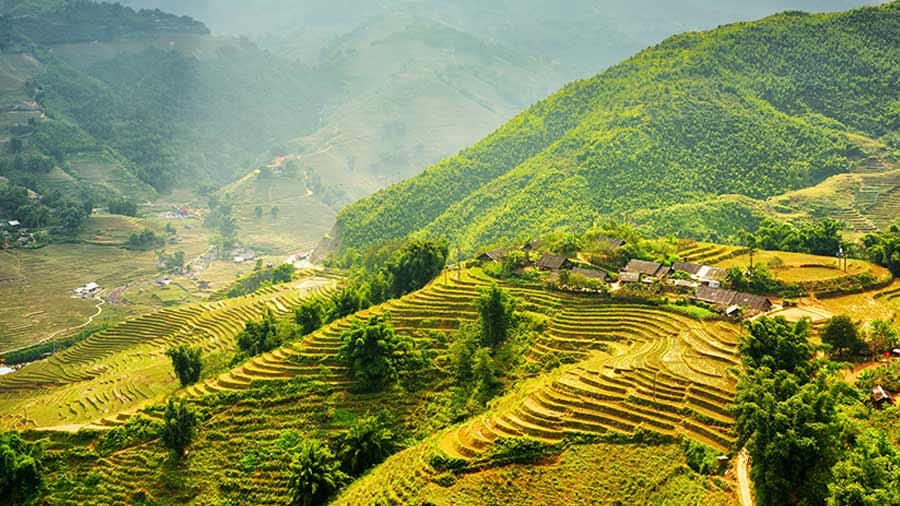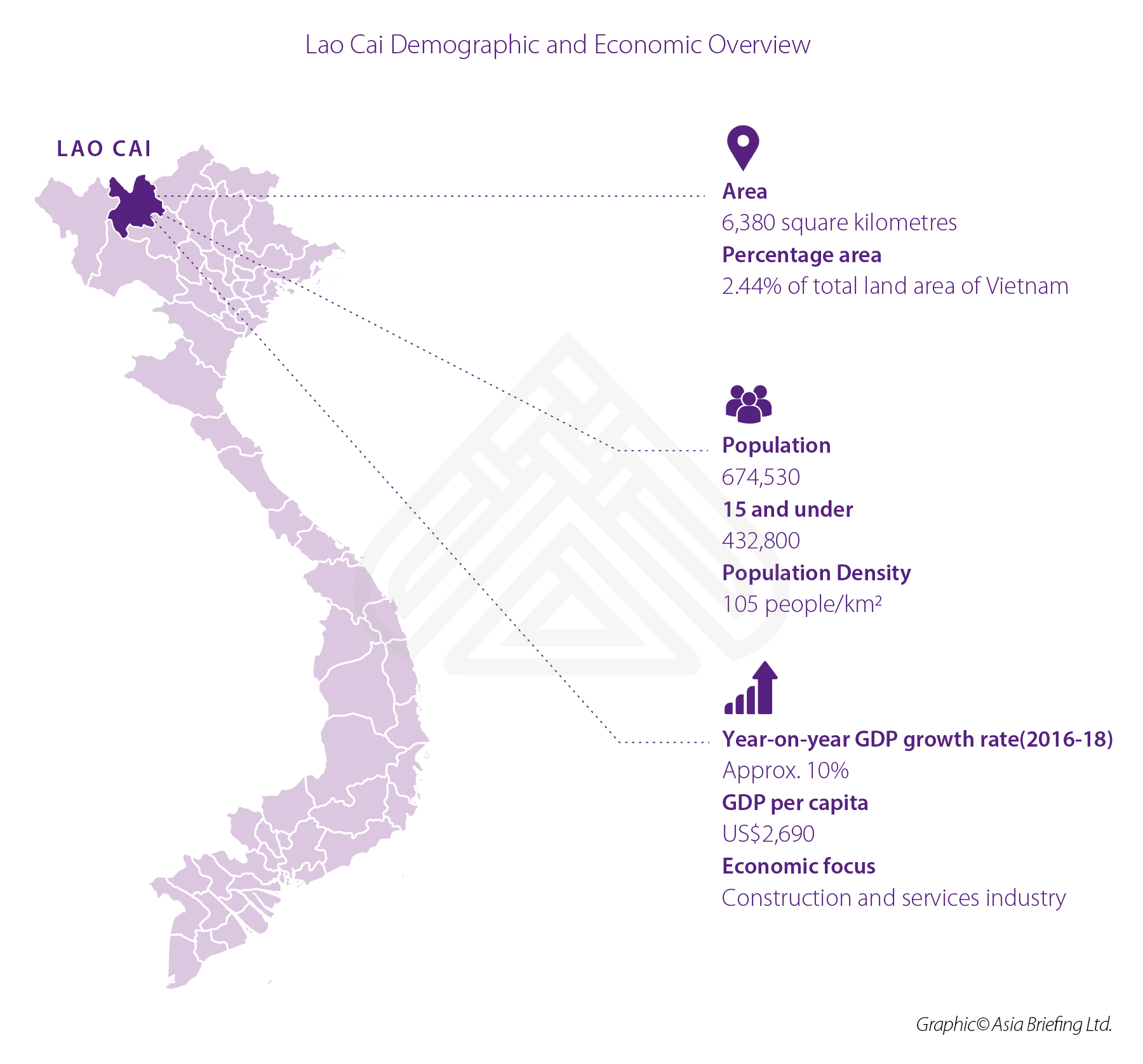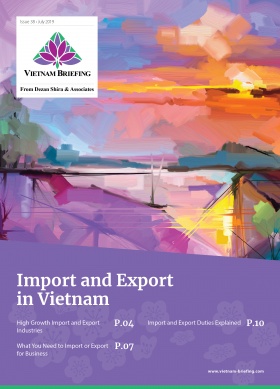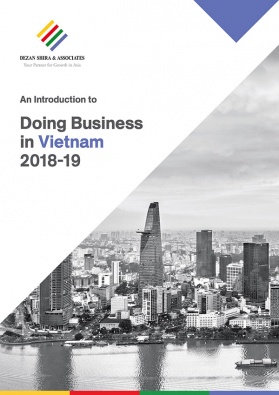Vietnam’s Lao Cai: An Investment Spotlight
- Lao Cai has developed as a major FDI destination and a major conduit for trade and investment between Vietnam and southwest China.
- Lao Cai is helped by its strategic location and a well-developed transportation network.
- Most recently local authorities have proposed a border market and trade center to promote investment.
In recent years, Lao Cai province has developed into a promising destination for foreign investments – especially in the tourism, construction, and agriculture sectors. This is partly a result of Lao Cai’s strategic location located on the Kunming-Haiphong economic corridor, sharing a border on the Yunnan province of China.
Lao Cai is now a major conduit for trade and investment between Vietnam and southwest China. Businesses with interests in both Vietnam and China should examine Lao Cai’s profile in greater detail to understand if locating in the province will provide a strategic advantage in comparison to other locations.
Still, the province is not for everyone. While the province’s growth prospectus is positive, investors will need to manage challenges like the poor state of infrastructure. Other challenges may include the accessibility of land, information access for businesses, human resource quality, and the quality of business support services.
Businesses that are able to manage these challenges to reap the benefits of the province’s strategic location and economic growth can win first-mover advantage.
Strategic location and infrastructure
Lao Cai is made up of eight districts: Bao Thang, Bat Xat, Bac ha, Muong Khuong, Sapa, Si Ma Cai, and Van Ban, as well as Lao Cai city. The province also has a favorable geographical location as it bridges the key economic corridor of Con Minh-Hanoi-Haiphong.
One of Lao Cai’s strengths is that it has a better transportation network compared to other mountainous provinces. There are five national highways – including national highways No. 70, 4D, 4E, 279 – and two rivers running through the province. The 152 miles (245 kilometers) Noi Bai-Lao Cai expressway shortens the traveling time between Lao Cai and the country’s capital Hanoi from seven to three and a half hours.
Other routes and transportation networks like the Hai Phong-Hanoi-Lao Cai corridor and China’s Kunming-Hekou railways help facilitate trade in the Kunming-Lao Cai-Hanoi-Haiphong economic corridor, an important free trade route and gateway of Vietnam to ASEAN countries and China.
The economic corridor connects a string of economic centers in Yunnan and northern Vietnam. The volume of goods transported between China and the Haiphong ports account for 25 to 30 percent of the total cargo. With improving infrastructure and transportation networks in the economic corridor, there has been a growing demand for freight services between the regions in recent years.
The nearest airport to Lao Cai is Noi Bai International Airport at 145 miles (237 kilometers) in Hanoi. However, a proposal to build an airport in the tourist hub of Sa Pa, Bao Yen was submitted earlier this year by the local government. The Sa Pa airport will be built according to the International Civil Aviation Organisation (ICAO) standards and have a designed capacity serving 2.5 to 3 million passengers every year.
While the province is seeking investments and funding from different sources like Vietnam Air Traffic Management Corporation, the state, and provincial budget, it’s also seeking investments from private investors in the construction of civil aviation area and fuel depots.
The province is home to a border-gate economic zone and three industrial parks. These industrial parks include:
- Tang Loong Industrial Park
- East Pho Moi Industrial Park
- North Duyen Hai Industrial Park
The East Pho Moi and North Duyen Hai Industrial Park are a part of the Lao Cai border gate economic zone, which also includes the Bat Xat district.
Key Industries
The provinces’ key industries include construction, services, and agriculture. We examine these in greater detail directly below.
Construction (Mining) Sector
The province is one of the richest in the country in terms of its mineral reserves. It has up to 35 different types of high-quality minerals, with around 150 mines – making it a competitive choice for mining and processing investments in Vietnam. Some of these reserves include apatite (2.5 billion tons in Cam Duong), iron (124 million tons in Quy Xa iron mine), copper (53 million tons in Sin Quyen mine), gold, graphite, and more.
Many mineral reserves in Lao Cai are already under deep processing. For example, more than three factories are processing apatite ore with a capacity of extracting 100,000 to 700,000 tons per year.
This year another notable construction investment in Lao Cai has been the hydro-plant project investment worth of US$35 million from a joint venture between the Northern Power Corporation and China’s Yunnan Power Grid Co.
Services (Tourism) Sector
Last year, with over 718,500 foreign arrivals and US$582.8 million earnings from its hospitality sector, the province has shown great prospects for investments in tourism and services. Sa Pa, Bac Ha, and Bat Xat districts, along with the Lao Cai city, are the most visited locations. Sa Pa alone saw 7,600 foreign arrivals last year. This year, the province expects to receive around five million tourist arrivals with 900,000 coming from foreign countries.
Lao Cai, apart from being home to a picturesque natural environment, is also home to 25 different ethnic groups with festivals and events all year round. For example, the Bac Ha temple festival in Bac Ha district and the Long Tong festival of the Tay ethnic group in the spring.
Due to its great natural and heritage sites, and places of interest like Sa Pa and Bac Ha, Lao Cai has a great capacity for developing into a key tourism center. Local authorities would like to diversify its tourist products as part of the province’s strategy to attract more tourist arrivals. The local governments have also been working to upgrade infrastructure facilities and promote community-based tourism.
As the province is near China’s Yunnan province, Chinese tourists make up the largest proportion of foreign arrivals in Lao Cai. In 2019, local governments plan to establish a “Two nations – Six destinations” travel tour into an official trademark tourism product connecting with Kunming city and Honghe prefecture of Yunnan.
Agriculture and Forestry
Lao Cai provides bright prospects for investments in its agriculture and forestry sector as well. It has mountains, rivers, forests and is home to 50 of Vietnam’s rare plant species. Some products grown in the highland area of the province provide a unique investment potential as they are rarely found in the lowlands.
Lao Cai’s highland area has a temperature of 15-20 degrees Celsius (59-68 Fahrenheit) – suitable for the cultivation of agricultural products like apples, pears, peaches, and off-season vegetables, as well as cold-water fish like salmon. The lowland is usually 23-29 degrees Celsius (73-84 Fahrenheit) making it suitable for the plantation of tropical fruit trees like pineapple, banana and tea materials.
Presently, many farms in Lao Cai cultivate banana, tobacco, pineapple, and tea products, which all bring high economic returns.
In the first half of last year, earnings from agricultural products transacted via Lao Cai international border gate increased 40 percent year-on-year earning more than US$250 million. Agricultural products like dragon fruits and litchis saw exponential growth in their export quantities with 688 percent and 162 percent growth, respectively. Such increment is attributable to the cutting of border-gate related fees and the easing in custom clearances.
FDI in Lao Cai
Between January and April this year, Lao Cai attracted 20 foreign direct investments (FDI) projects. A majority of the projects came from Chinese investors, while other investments came from Singapore, South Korea, Denmark, Norway, the UK, and the US. Combined, they all had a registered capital of US$540 million.
Since April, the province has approved eight more investment projects in sectors like tourism and services, urban development, industry, and pharmaceutical development. These projects have a total capital of US$1 billion.
One of the most notable investments was made by a joint venture between Vietnam Steel Corporation and China’s Kungang, -iron and steel company. Together, they invested in a US$337.5 million joint-venture iron-mining investment project. Another notable investment was a US$75 million five-star Aristo hotel project from Singapore.
Prospects and incentives
Local authorities are striving to attract more investment in the copper and iron processing industry. They are also seeking more investments in the tourism and hi-tech agriculture sector, especially in Sa Pa and Bac Ha districts. They also hope to receive more investments in the logistics and warehousing sector in the Lao Cai border gate economic zone.
Local authorities have proposed to build a border market and trade center to attract investment given its proximity to China. The project will include three different zones with one for regular products, one for border residents’ markets and the other for wholesale markets for agricultural and aquatic products.
Provincial authorities are planning to call for investments worth US$8.6 million (VND 200 billion) and finish the project in the 2020-2022 period though land lease auctions.
As a part of their strategy, the Lao Cai People’s Committee has been working to reduce the time required for administrative formalities, simplifying investment, tax, and customs procedures. Other substantial incentives provided include:
- Land rental exemption of 11 years for investment projects in priority sectors;
- Land rental exemption of seven years for other investment projects;
- Corporate Income Tax (CIT) exemption for four years starting from the year when taxable income is generated; and
- 50 percent CIT reduction for the subsequent nine years
Last year, the province ranked 25th in the Provincial Competitive Index (PCI) 2019 rankings.
Lao Cai – China trade
China is Vietnam’s largest trading partner and source of imports, and Lao Cai is a major contributor to those statistics. Chinese investments make up 75 percent of Lao Cai’s total FDI figures, while trade revenues reached US$106 billion last year.
In the first half of 2018, trade between the two countries reached over US$1.55 billion, up 29 percent year-on-year and 55 percent more compared to 2016, through the Lao Cai-Hekou border gate. Fruits and agro-aquatic products accounted for most of the exports bringing in more than US$306 million.
To boost trade relations with China, particularly with Yunnan province, Lao Cai plans to build another rail network to Yunnan. The railway network will start from Lao Cai and pass through eight other cities and provinces including Hanoi, and end in Haiphong in Vietnam before linking up with a track to Hekou Yao autonomous county in China.
About Us
Vietnam Briefing is produced by Dezan Shira & Associates. The firm assists foreign investors throughout Asia from offices across the world, including in Hanoi and Ho Chi Minh City. Readers may write to vietnam@dezshira.com for more support on doing business in Vietnam.
- Previous Article Despite Economic Slowdown, Vietnam Banks on Domestic Tourism and Real Estate
- Next Article Vietnam-EU Trade: EVFTA Comes Into Effect









